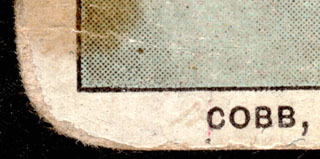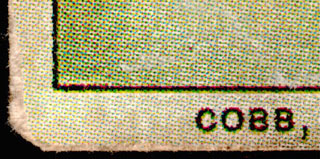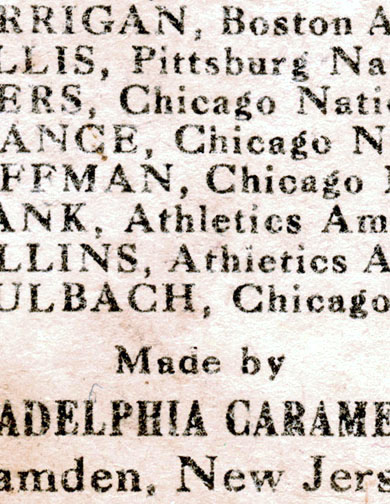
This is the front of an original E95 Ty Cobb card. As you can see, the "white" of the the outer border is really the white of the stock the card is printed on. There is NO printing of any kind in this area, except for the text.
Other elements to pay close attention to:
Black line surrounding the picture image: (Original) This border that surrounds the image is made up of ONE ink color - black. Even though it is not always even, It's edge quality is distinct and clean.
Text: (Original) The text is made up of one ink color - black. Edges are clean and distinct. Overall letter quality is nice and text has nice contrast to the surrounding "white" area.
You can also see in the picture area (his uniform) the dot pattern being used to create shades in the uniform. Note that only black ink is used with this technique. Note the gray of his uniform is one flat area in coverage and contains to dot patterns.
NOTE the even roundness of the corner. The reprint has "rounded" corners also when viewed with the naked eye but upon magnification you see what is actually a distinct purposeful cut angle.

This is the front of a reprint E95 Ty Cobb card. When this set was reprinted they used the entire area of the card and converted everything to continuous tone dot patterns. This included the white outer border of the original. As you can see, the "white" of the the outer border now has printers dots covering the entire area of the border. The "white" border is now a light gray in appearance when viewed without any type of magnifying glass. This is a 100% sure sign the card is a reprint.
Other elements to pay close attention to:
Black line surrounding the picture image: (Reprint) This line that surrounds the image is now made up of all four of the process ink colors. Since registration of a line like this is difficult with modern techniques, except from a very good print shop, in addition to black you can see areas of magenta, cyan and yellow used to create the lines appearance.
Text: (Reprint) The text is now made up of all four process ink colors also - magenta, cyan, yellow and black. Edge quality is very poor and the green color you see around the letters is created by the cyan and yellow inks overlapping. You also see areas of magenta around the edges of the lettering. Overall letter quality is poor and text has less contrast to the surrounding "white" area which now looks like a light shade of gray.




